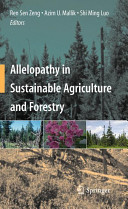Allelopathy in Sustainable Agriculture and Forestry
| Series: | |
| Publisher: | Springer New York |
| Subject: | Allelopathy, Sustainable agriculture |
| Authors: | Ren Sen Zeng , Azim U. Mallik , Shiming Luo |
| Pages: | 412 pages |
| Binding: | Hardcover |
| ISBN: | 9780387773360 |
| Call No: | SB 732.75 A435 2008 |
Simply put, allelopathy refers to an ecological phenomenon of plant-plant interference through release of organic chemicals (allelochemicals) in the environment. These chemicals can be directly and continuously released by the donor plants in their immediate environment as volatiles in the air or root exudates in soil or they can be the microbial degradation products of plant residues. The chemicals may interfere with survival and growth of neighboring or succeeding plants. Black walnut, eucalyptus, sunflower, sorghum, sesame and alfalfa are common examples of plants with allelopathic property as well as some staple crops such as rice, wheat, barley and sorghum. Plants can emit chemicals that also discourage insects and pathogens. To maintain sustained productivity, knowledge of this form of plant interference on other plants and on disease causing organisms has been used in agriculture since prehistoric time by manipulating cropping pattern and sequence such as mixed cropping and crop rotation.

